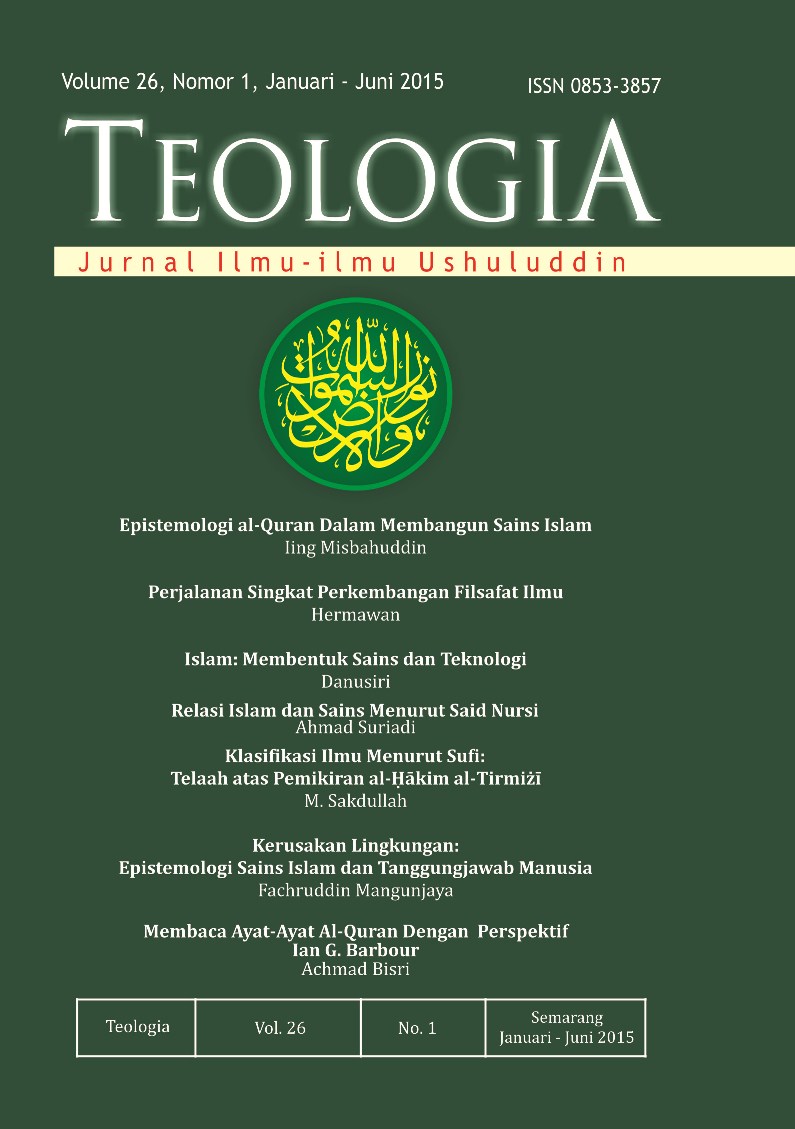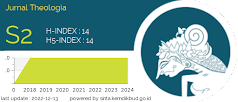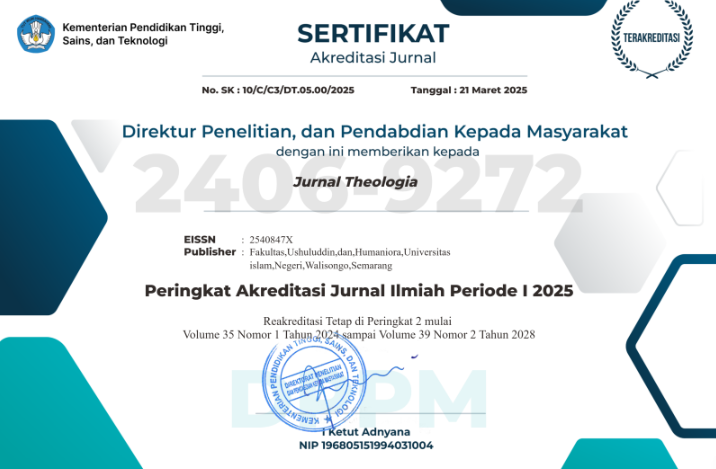BENDA ASTRONOMI DALAM AL-QURAN DARI PERSPEKTIF SAINS
DOI:
https://doi.org/10.21580/teo.2015.26.1.409Abstract
Abstract: The objects in the sky in an astronomical perspective is very much the type and amount, but in the perspective of The Quran consists only of the sun, moon, and stars. The Quran gives cues and clues about the movement of the heavenly bodies. Sky objects in the perspective of the Koran already set his destiny, and had been subdued, so consistently and definitely outstanding. According to The Quran cue each celestial bodies, circulation and no silent, including the sun are also outstanding. In the circulation of the month, has its own characteristics, because only months in circulation set manzilah-manzilah, so the moon when seen from Earth show different form, sometimes the perfect (full moon), and sometimes show an imperfect form. Thus, it can be well known, when the month of the date of 1,2,3, and so on, so that people can practice their religion is based on the moon trip. Abstrak: Benda-benda di langit dalam perspektif astronomi sangat banyak jenis dan jumlahnya, namun dalam perspektif al-Quran hanya terdiri dari matahari, bulan, dan bintang. Al-Quran memberikan isyarat dan petunjuk mengenai pergerakan benda-benda langit tersebut. Benda-benda langit dalam perspektif al-Quran sudah ditetapkan takdir-Nya, dan telah ditundukkan, sehingga beredar secara konsisten dan pasti. Menurut isyarat al-Quran masing-masing benda langit, beredar dan tidak ada yang diam, termasuk matahari juga beredar. Dalam peredaran bulan, memiliki ciri tersendiri, karena hanya bulan yang dalam peredarannya ditetapkan manzilah-manzilah, sehingga bulan ketika dilihat dari bumi menunjukkan wujud yang berbeda-beda, kadang sempurna (bulan purnama), dan terkadang menunjuk-kan wujud yang tidak sempurna. Dengan demikian, dapat dikenal dengan baik, kapan bulan tanggal 1,2,3, dan seterusnya, sehingga manusia dapat melaksanakan ibadah berdasarkan perjalanan bulan tersebut. Keywords: matahari, bulan, bintang, al-Quran, astronomiDownloads
References
Depag RI, Islam Untuk Disiplin Ilmu Astronomi, Jakarta: Dirjen Bagais, 2002.
Djambek, Saadoe’ddin, Hisab Awal Bulan, Jakarta: Tintamas, 1976.
Humad, As’ad Mahmud, Aysar al-Tafāsīr:Tafsīr, Asbāb al-Nuzūl, al-Ḥadīṡ Namāzij I’rab, Damaskus: tp, 1992.
Ibn Kaṡīr, Tafsīr al-Qur’ān al-’Aẓīm, ditahqiq oleh Samī bin Muhammad Salāmah, Dār Ṭayyibah linasyri wa al-Tauzī’i,tp, 1999/1420 cet II.
Ibn Manżūr, Muhammad bin Mukrim bin Manżur al-Ifriqī al-Miṣrī, Lisān al-A’rabi, Beirut-Lebanon: Dār Ṣādir, tth.
Ichwan, Muhammad Nor, Tafsir ‘Ilmi Memahami al-Quran melalui Pendekatan Sains Modern, Jogyakarta, 2004.
Jailani, Zubair Umar, al-Khulāṣah al-Wafiyyah fi al-Falak bi Jadwal al-Lughāritmiyyah, Kudus: Menara Kudus, t.t
Khazin, Muhyidin, Ilmu Falak, Yogyakarta: Buana Pustaka, 2004
Mahlī dan as-Suyutī, tt. Tafsir al-Jalālain,tp,tt.
Munawir, AW, Kamus Arab-Indonesia, Surabaya:Pustaka Progresif, 1997
Poedjawijatna, Pembimbing Ke Arah Alam Filsafat, Jakarta: PT Rineka Cipta, 1997.
Quraish Shihab, Tafsir al-Misbah, Vol. 3, 4, 10, 11, 12, 13, 14, Jakarta: Lentera Hati, 2006.
Sa’di, ’Abdu al-Rahman bin Nāśir bin al-Sa’di, Tafsīr al-Karīm al-Rahman fī Tafsīr Kalām al-Manān, tahqiq ’Abd al-Rah-man bin ma’lā al-Wīhaq, Beirut: Muassah al-Risalah, tth.
Ṭabarī, Muhammad bin Jarīr bin Yazid bin Kaśir bin gālib al-Amlī, Jāmi’ al-Bayān fī Ta’wīl al-Qurān, juz 24, tahqiq Ahmad Muhammad Syākir, Beirut:Muassah ar-Risalah,tt cet I
Wicks, Keith, Stars And Planet, terj. Bambang Hidayat London: Grisewood & Dempsey Ltd, 1997.
Zamakhzari tt, Tafsir al-Kassyaf, juz 2, tp.
Zuhaili, Tafsīr al-Munīr, Juz 11, 12, 13, 21, 23, Beirut: Dār al-Fikr al-Ma’aṣir, 1991















